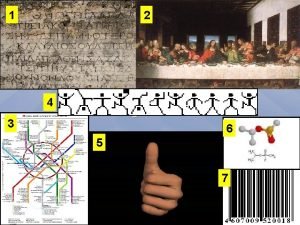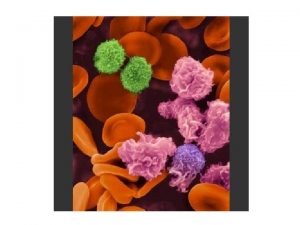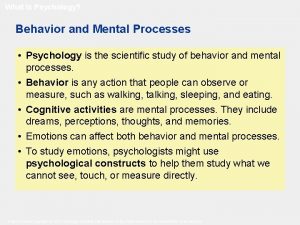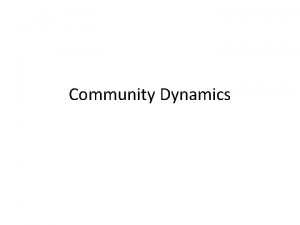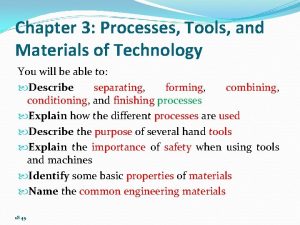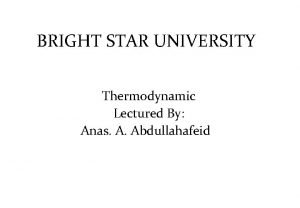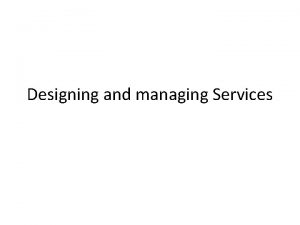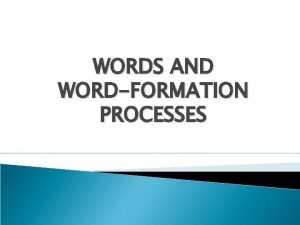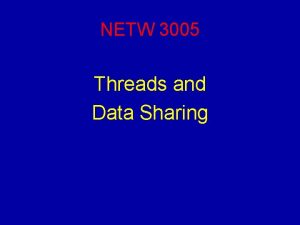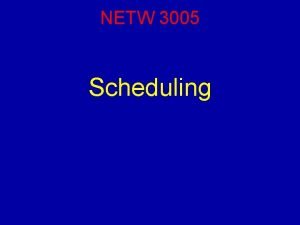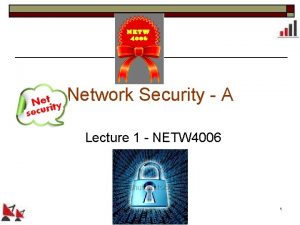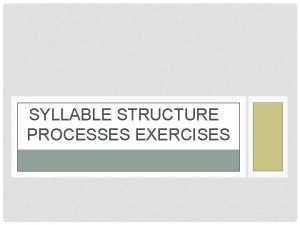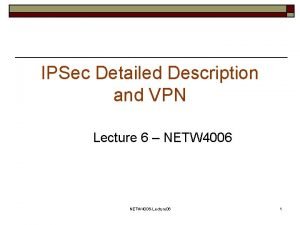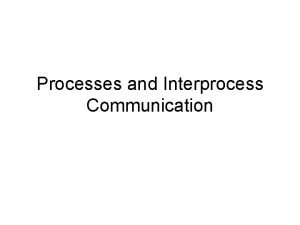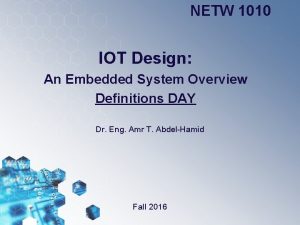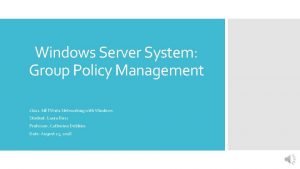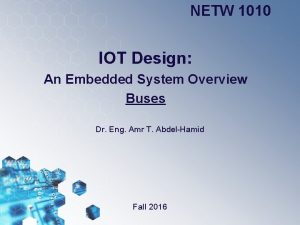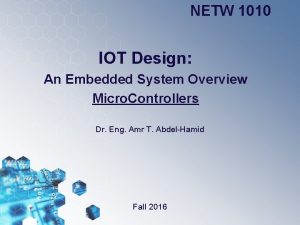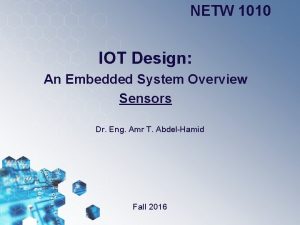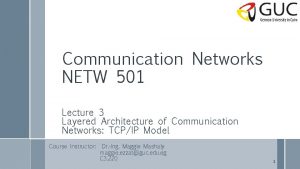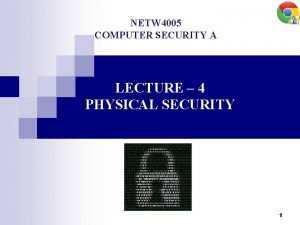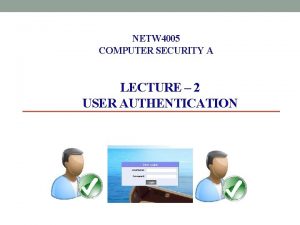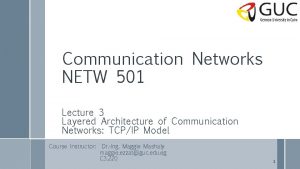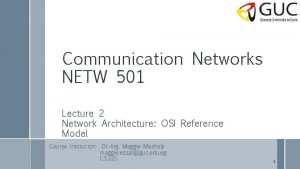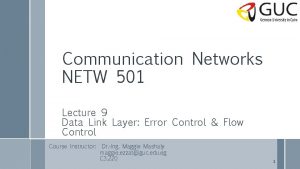NETW 3005 System Structure and Processes Last lecture


























- Slides: 26

NETW 3005 System Structure and Processes

Last lecture • History and types of operating systems: – batch systems, multiprogramming systems, time sharing systems, etc. • Operating system tasks: – process management, storage management, I/O device management, user interface. NETW 3005 (Operating Systems) Lecture 02 - System Structure & Processes 2

This lecture • Hierarchical Structure in Operating Systems • System calls and interrupts • Representing processes in Operating Systems • Overview of process scheduling. NETW 3005 (Operating Systems) Lecture 02 - System Structure & Processes 3

Layered Approach • The operating system is divided into a number of layers (levels), each built on top of lower layers. The bottom layer (layer 0), is the hardware; the highest (layer N) is the user interface. • With modularity, layers are selected such that each uses functions (operations) and services of only lower-level layers

Hierarchical structure in OS • An operating system must be carefully designed and one central requirement is modularity. • Distinction between system programs, application programs and kernel programs • Different operating systems enforce different degrees of modularity. • Ideally you want to oblige all system and application programs to talk to the hardware via the kernel. NETW 3005 (Operating Systems) Lecture 02 - System Structure & Processes 5

MS-DOS Application programs System programs Kernel operations Device drivers NETW 3005 COSC 243 (Operating Systems) Terminal drivers Memory manager Lecture 02 - System Structure & Processes 6

System calls • Programming interface to the services provided by the OS • Written in the same language as kernel (typically C or c++). • The set of system calls is termed the programmer interface to the system. • Example : • Win 32 API for Windows • POSIX API for UNIX , JAVA API for JVM NETW 3005 (Operating Systems) Lecture 02 - System Structure & Processes 7

Talking to the kernel: system calls System Program ‘‘read from the keyboard’’ ‘‘open a file’’ ‘‘write to the screen’’ Kernel Hardware NETW 3005 (Operating Systems) Lecture 02 - System Structure & Processes 8

Types of system call • Process control – create, terminate, suspend, resume, abort. • File manipulation – open, close, read, write • Device manipulation – request, release, read, write. • Housekeeping – get/set time or date – get/set attributes (process, device, file) • Communications – set up link, – send/receive message NETW 3005 (Operating Systems) Lecture 02 - System Structure & Processes 9

Examples of Windows and Unix System Calls

System Call Implementation • Typically, a number associated with each system call – System-call interface maintains a table indexed according to these numbers • The system call interface invokes the intended system call in OS kernel and returns status of the system call and any return values • The caller need know nothing about how the system call is implemented – Just needs to obey API and understand what OS will do as a result call – Most details of OS interface hidden from programmer by API • Managed by run-time support library (set of functions built into libraries included with compiler)

API – System Call – OS Relationship

Process Concept • Process – a program in execution; process execution must progress in sequential fashion • PCB stores Information associated with each process

Components of a process • Code section: section the program code itself • Data section: section any global variables used by the program • Process stack: stack any local variables currently being used (subroutine parameters, return addresses, etc. ) • Program counter: counter a pointer to some place in the program code. • Contents of CPU registers • Memory management information • Accounting information: information who owns the process, how long it’s been running, how much CPU time it’s used so far, etc. NETW 3005 (Operating Systems) Lecture 02 - System Structure & Processes 14

Process State • As a process executes, it changes state – new: The process is being created – running: Instructions are being executed – waiting: The process is waiting for some event to occur – ready: The process is waiting to be assigned to a processor – terminated: The process has finished execution

Diagram of Process State

CPU Switch From Process to Process

Process Scheduling • Maximize CPU use, quickly switch processes onto CPU for time sharing • Process scheduler selects among available processes for next execution on CPU • Maintains scheduling queues of processes – Job queue – set of all processes in the system – Ready queue – set of all processes residing in main memory, ready and waiting to execute – Device queues – set of processes waiting for an I/O device – Processes migrate among the various queues

Types of scheduler • Long-term scheduler (batch systems): decides which jobs loaded onto the disk should be moved to main memory. • Short-term scheduler (a. k. a. CPU scheduler): chooses how to allocate the CPU between the processes which are ready to execute. NETW 3005 (Operating Systems) Lecture 02 - System Structure & Processes 19

Representation of Process Scheduling n Queueing diagram represents queues, resources, flows

Operations on Processes • System must provide mechanisms for: – process creation, – process termination, – and so on as detailed next

Process Creation • Parent process create children processes, which, in turn create other processes, forming a tree of processes • Generally, process identified and managed via a process identifier (pid) • Resource sharing options – Parent and children share all resources – Children share subset of parent’s resources – Parent and child share no resources • Execution options – Parent and children execute concurrently – Parent waits until children terminate

A Tree of Processes in Linux

Process Creation (Cont. ) • UNIX examples – fork() system call creates new process – exec() system call used after a fork() to replace the process’ memory space with a new program

Process Termination • Process executes last statement and then asks the operating system to delete it using the exit() system call. • Parent may terminate the execution of children processes using the abort() system call. • The parent process may wait for termination of a child process by using the wait()system call.

Next Lecture Threads and Data Sharing
 0001 0011
0001 0011 Concurrent processes are processes that
Concurrent processes are processes that 01:640:244 lecture notes - lecture 15: plat, idah, farad
01:640:244 lecture notes - lecture 15: plat, idah, farad Randy pausch the last lecture summary
Randy pausch the last lecture summary Algo and amal
Algo and amal Power system dynamics and stability lecture notes
Power system dynamics and stability lecture notes Power system dynamics and stability lecture notes
Power system dynamics and stability lecture notes My last duchess power and conflict
My last duchess power and conflict Operating system lecture notes
Operating system lecture notes Zline 667-36
Zline 667-36 Unified health management information system
Unified health management information system Education thymique
Education thymique My last duchess structure
My last duchess structure Is earth an open or closed system
Is earth an open or closed system Site:slidetodoc.com
Site:slidetodoc.com Study of behavior and mental processes
Study of behavior and mental processes Wharton risk center
Wharton risk center What is community dynamics?
What is community dynamics? Tools equipment and processes
Tools equipment and processes Irreversible process in thermodynamics
Irreversible process in thermodynamics Hsc multiple choice generator
Hsc multiple choice generator Helping students practice skills, strategies, and processes
Helping students practice skills, strategies, and processes How to designing and managing service processes
How to designing and managing service processes Multiple processes word formation examples
Multiple processes word formation examples Marketing processes and consumer behavior
Marketing processes and consumer behavior Participants processes and circumstances
Participants processes and circumstances Designing and managing service processes
Designing and managing service processes
